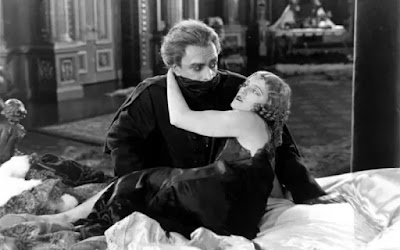As far as silent horror films go, The Man Who Laughs is one of the most widely known, it's popular recognition falls only behind the likes of Nosferatu (1922) and The Phantom of the Opera (1925). A myriad of trivia is regularly tossed out in regards to the film, including that is actually a Universal horror film (making Gwynplaine a "Universal monster"), and, most famously of all, that the character/visage of Gwynplaine was the inspiration for the Joker character in the DC Batman comics. And, it arguably remains the best adaptation of a Victor Hugo novel. I wanted to breifly touch on just a few lesser known aspects of the film (including a few personal notes of favor on my part); elements that make the film a true milestone in the world of cinema.
The first important aspect of the production being a Universal film: Universal was the studio that gave us the 1923 Hugo adaptation The Hunchback of Notre Dame starring the great chameleon Lon Chaney. It was such a success that the studio fully intended to have him star in another Hugo adaptation of L'homme qui rit, this was the first step at Universal to put the film, translated into English as The Man Who Laughs, into production. There was even a contract drawn up with Chaney; but the studio had failed to acquire the rites to the novel for film adaptation from the French studio that owned them. The result was that the project was shelved and Chaney's stared in the now extremely famous production of The Phantom of the Opera instead. The success of that film allowed German ex-pat producer Carl Laemmle to return to The Man That Laughs project with complete control of the production. He wasted no time in hiring a bevy of fellow Germans for the production, including Conrad Veidt, who who effectively lured to Hollywood by the studio; and director Paul Leni. He too had been brought to Hollywood by Laemmle. To round out the cast, Mary Philbin (most definitely an American thespian!), who appeared as the female lead in Phantom, was cast as Dea.
Leni got his start--like so many directors of late 1920's gothic films turned out of American studios--as an expressionist director in Germany. His direction of the expressionist master-class Das Wachsfigurenkabinett (Waxworks) had garnered international attention and prompted Laemmle to hire him for Universal. By the time that he was brought on to this Hugo project, he had already directed two mystery films for Universal (the Charlie Chan vehicle The Chinese Parrot and The Cat and the Canary--now a late 20's horror classic). Leni was as "arthouse" as they came (his Rebus shorts, initially shot as theatrical "extras," are/were partially or fully animated avant-garde films--at least one of which survives), but his first two Hollywood efforts showed the constraints of such a director working in the money machines that were the Hollywood studios. The Man Who Laughs however shows that he was finding his place. The film contains much of his pre-Hollywood direction style and hints at great works to come (even with the coming of sound). Alas, this was not be. Leni died in 1929 at just the age of 44 from sepsis brought on my a tooth infection of all things. It was a huge loss to the art of filmmaking!
Another interesting little point of trivia of the film is that having been made and released right on the cusp of all sound films, a partial soundtrack was later made for the film with the brand new (and quickly monopolistic) Movietone sound system. This simplistic soundtrack, which mostly consisted of tones from bells and knocks, with the occasional brass flourish, was constructed around the song "When Love Comes Stealing."
In regards to the plot of film, there are those who consider it a dark romance, or work of strange tragedy; even a few who dispute it being any type of horror film at all. This despite it's undeniable gothic foundations. For me personally, it is a film about the horror of being ostracized by society, of being an outcast, a rejected human being. If you have endured even the mildest of bullying in a school environment or any situation where a bad actor has agency or power over you, then you know first hand this is indeed a horror film. The horror of institutional shame, and the desperate need to flee from it, are the things post traumatic stress are made of. So for me, a person who lives with PTSD, this is high on my list of scariest horror films out there. It is also high of my list of the best of the best horror ever made in these United States. Sad, sickening and devastatingly beautiful!






Great piece...and I've never seen this film, so now I want to! Have added it to my Halloween watch list
ReplyDelete